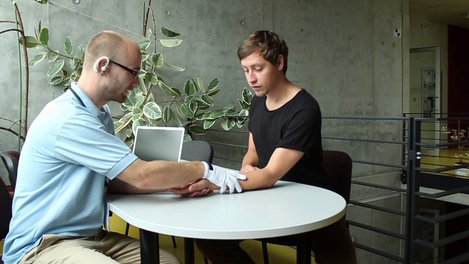Laying-on of hands with a medical method

Dessau designers develop a diagnostic glove
The Investment and Marketing Corporation Saxony-Anhalt (IMG) will be presenting the life science location Saxony-Anhalt at the CPhI Worldwide in Madrid from 13 to 15 October. The state will be presenting a profiled research infrastructure at the trade fair, which is regarded as the largest worldwide for the pharmaceutical industry. The profile also entails that sharp minds provide ideas. Designers Thomas Kores and Philipp Rösler from Dessau will show how people can courageously and creatively “think outside the box” in this part of the world. They developed a concept for a medical diagnostic glove and received the first prize for this at the BESTFORM state-wide competition in July.
It is an invention which could change doctor’s visits. Philipp Rösler and Thomas Kores have combined the function of several medical devices in one “glove”. Conventional examination aids such as stethoscope, thermometer or heart rate monitor were able to be woven in as sensors. “A doctor can establish direct contact with patients during their examination through gestures and touching. As a result, the relationship between doctor and patient is clearly improved”, says Philipp Rösler. The jury of the state-wide competition BESTFORM also saw it just the same and awarded the two graduates of the bachelor degree course “Integrated Design” at the Anhalt University of Applied Sciences in Dessau with the first prize. The jurors emphasised that “the method of examination” is “impressively humane” and praised the designers for their “competence to recognise and solve problems”. This technology enables the focus on the essentials: the direct contact between doctor and patient.
The designer duo designed their “MediGlove” during a practical seminar at the university. They worked four months on the innovation. “We considered how we can usefully expand technical concepts”, says Philipp Rösler. “The glove was an exciting and useful solution.” The sensors utilised are nothing new, but the combination in one glove certainly is. Thomas Kores: “We placed existing materials in a new context and made it possible that work can be performed by means of natural gestures.” Data which will be transmitted by the sensors can be transferred by means of a processor module to a computer and stored in the patient file.
Support for this idea came from the Stuttgart company “mm1 Consulting & Management” that was on hand in an advisory and promotional capacity. The alliance of creative individuals and a company from another branch of industry was the most important prerequisite for submitting the project during the competition. And the economic partnership was also helpful, because the student project is still in the initial stages. Both designers see the prize money as start-up assistance – with which, by way of example, a prototype could be realised. Kores and Rösler agree that “we must invest if we would like to make progress with the project”. That’s why the attention which the first prize brought came at just the right time. Newspapers and magazines reported about the “MediGlove” and the ideas of the designers from Saxony-Anhalt. They are exchanging ideas with physicians and companies. “This came unexpectedly for us”, says Philipp Rösler. “As a result, the project is no longer so abstract and the implementation has become more tangible.” This includes the fact that they speak in public about their “glove”. “Probably nobody will hear us in private”, says Thomas Kores.
But something else important is currently happing in private. The designers have invested in new technology and equipped themselves with sensor sets and microprocessors. Both are united by the fact that they can also technically implement their creative ideas. “It is important to know which shape something has to have, but one also has to be able to try it out”, says Philipp Rösler. Of course, both say that they also have other ideas, because “as creative minds” they also “simply like to get weird ideas and develop new things”. But they say that the “MediGlove” diagnostic tool is the focal point of their work. “We have realised how great the interest is”, says Kores, “we will stick to that”. After the important work of carrying their idea into the world, the step towards depth and concentration follows now. The inventors continue to research, look around for partners and exchange ideas with medical technology companies – in short, they are working on the “MediGlove” to eventually manage the leap onto the market. At the moment they are also working “on the side” to earn a master’s degree in “Transformation Design”. “The good thing is that we can then implement theoretical knowledge in our project”, says Thomas Kores.
Author and Photo: Manuela Bock
